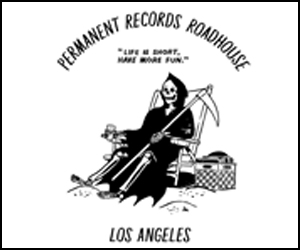‘The Dancing Man of L.A.’ has his moves (and a theme song) ready for the return of shows
Britt Witt on
1

Howard Mordoh is wasting no time. Post-pandemic concert tickets are going on sale, and he’s fired up: “Erasure at the Venetian Theatre in Vegas, Tame Impala at the Hollywood Bowl, Foo Fighters at the Forum,” he says, listing the tickets he just purchased. And he’s already strategizing the next day’s on-sales that include the Just Like Heaven festival, Sleigh Bells, Lorde and Sparks.
“I’m already getting conflicts,” he frets. “I couldn’t go to any of Todd Rundgren’s three nights at the Belasco because I’ve already got shows every night.” He pauses to laugh: “Everything came in at once. Last month, I spent $10,000 on tickets.”
Mordoh is a staple of the front row (or whichever row he can snag) at pretty much any concert you’ll go to in Los Angeles. “There’s the bar, there’s the stage, oh! There’s Howard,” KROQ DJ Kat Corbett divulges in the new PBS mini-documentary, “The Dancing Man of L.A.”
Now 70, Mordoh is a southern California native who spent 35 years as a clinical laboratory scientist and has been a concert enthusiast his whole life — just check his library of 8MM films he personally shot of iconic shows in the late ’70s and his collection of hundreds of ticket stubs. He attends more concerts in one year than many people do in their lifetime. And he has danced at every single one of them.
Known alternately as “LA Rocker” or “The Dancing Man” or “Front-Row Mordoh,” he has become well-known to veteran show-goers — and a curiosity to occasional fans and musicians alike for his spirited shuffling, twirling and boogieing, returning all the energy coming from stage threefold.
Co-directors Jen Fodor, who hosts the podcast I Love Music, and Scott Sheppard, whose filmography includes documentaries, commercials and shorts, knew this was a story that needed to be told.
Fodor had read the 2017 LA Weekly story on Mordoh and thought, “That’s that guy I see at all the shows dancing and spinning. I need to have him on my music podcast!” The two became fast friends, and she hatched the idea of doing a documentary. It was kismet at the Bon Iver/Sharon Van Etten show at the Forum in 2019 when the three attended the concert separately. Sheppard spotted Mordoh dancing and texted Fodor the next day, asking, “Do you still want to shoot that doc about Howard?” Says Fodor: “Pretty much that show sparked us starting to work on the doc.”
Mordoh often doubles or triples up on shows. “Who needs Coachella when I can run around L.A. and go to two-three shows in one night?” he tells Buzz Bands LA with a laugh. In the documentary, he enthusiastically shared with viewers his color-coded calendar of concerts, secondary shows and other appointments. That, of course, was pre-pandemic. And yes, the lockdown left Mordoh in an existential crisis, often depressed and agonizing over images of “see-you-soon” messages on venue marquees and resorting to virtual shows to try to get his fix.
Sheppard explains that the filmmakers had to finish the documentary with virtual interviews. “Mordoh would have a different mood every time, but it would always end in a dance party,” Sheppard says. “He would just start playing music and we would have an unplanned virtual dance party. We all really needed that during that time.”
While the pandemic has been a hard pill to swallow for everyone across the music industry, Mordoh’s passion is not gone. He’s excited to be back, to see people, “I’m going to be hugging a lot of people, more than usual,” he laughs. How did he stay in dancing shape? Hiking, he says, including visiting places he had never been to, such as the Hollywood sign, Santa Monica Mountains and Lake Hollywood.
He enthusiastically recalls the most expensive ticket he ever got: Elton John and Tina Turner for $650. “Totally worth it,” he says, “and it was Y2K when everyone was afraid to go anywhere — Las Vegas was empty, it was the best New Year’s I’ve ever had!” Vegas isn’t the farthest he’s traveled for a show — he flew to London for the Freddie Mercury Tribute Concert at Wembley Stadium in 1992 and to Amsterdam in 2011 when Robbie Williams reunited with his band Take That.
As for advice for concert-goers: “Just be yourself,” Mordoh says.
“The biggest thing is I want people to see Howard’s love of music and love of concerts,” says Fodor, who was inspired to write and record a song as a tribute to him, “Front Row,” featuring Nadia Vaeh.
“The Dancing Man of L.A.” is timeless and especially cathartic for those who have missed live music during the pandemic. It’s a love letter to the L.A. music scene and to the venues that have been hit hard. Plus, it’s a reminder not to take the experience for granted and, like Mordoh does, to seize the moment.
“I think [the documentary] is a great reintroduction to live concerts,” says Sheppard, adding that he hopes those who commune with Mordoh will respect his space despite the Dancing Man’s carefree moves. “Howard’s not really a rule-follower. He’s looking for ways to get a better experience in any situation.”
“I’ve asked Scott to be my bodyguard now,” says Mordoh, who will be back in his native habitat on Saturday night at the Hollywood Bowl for the July 4th Fireworks Spectacular featuring Kool & the Gang.
||| Watch: “The Dancing Man of L.A.”
||| Stream and watch the video (filmed at Zebulon) for Jen Fodor’s song, “Front Row”




God Bless Howard